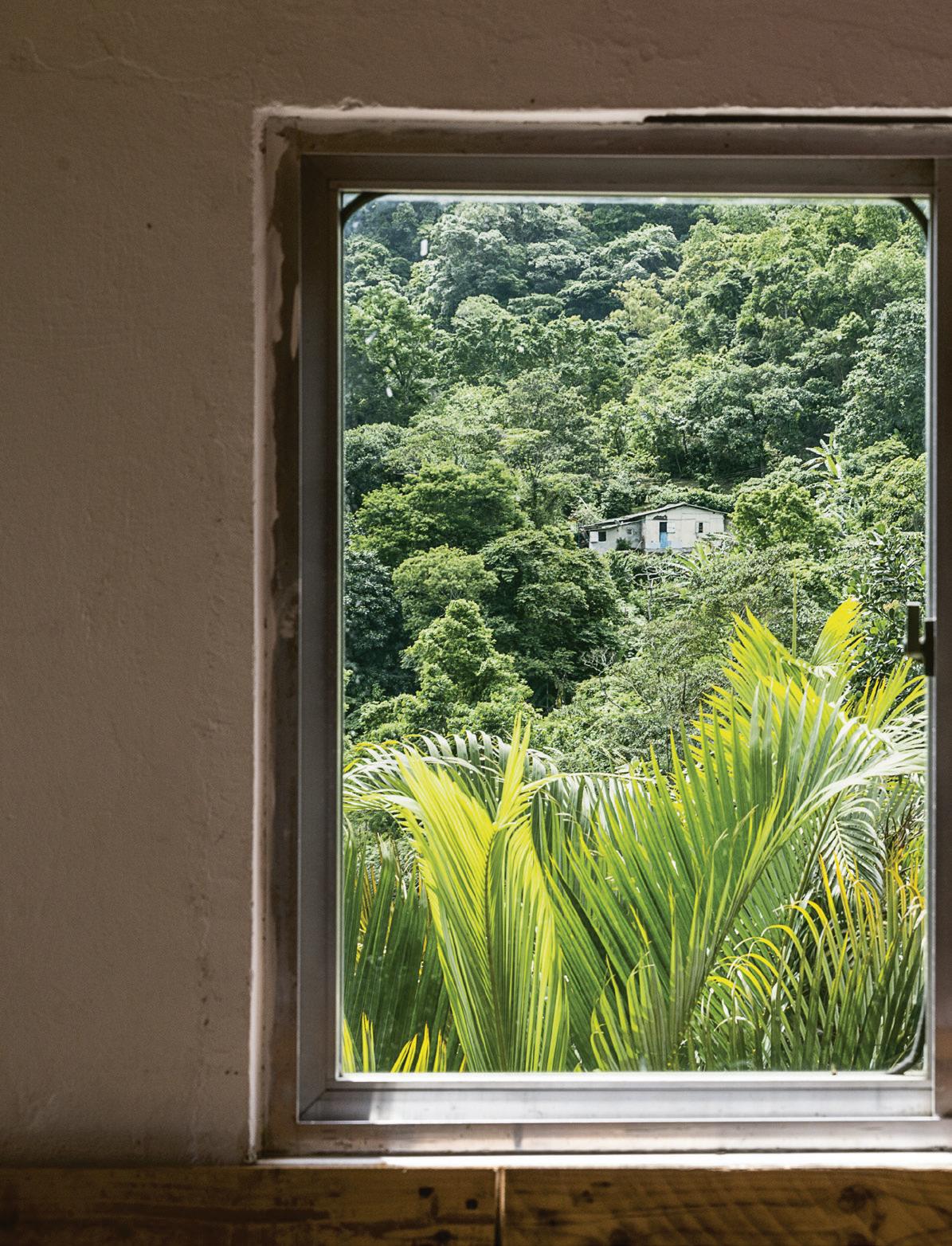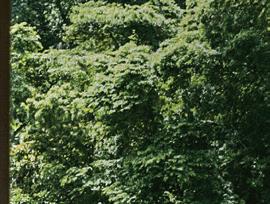
7 minute read
GAME SET AND BATS HIDDEN TREASURE URBAN JUNGLE







urban
JUNGLE
IN THE MIDST OF RIO’S URBAN INTENSITY, JUST MINUTES FROM THE BEACHES AND THE TUMULTUOUS CENTRO, LIES A MASSIVE FOREST SPANNING NEARLY 40 SQUARE KILOMETRES. HEMMED IN BY THE CITY, THIS OASIS BEEN THREATENED SEVERAL TIMES BY HUMAN PRESENCE. IT NEVERTHELESS PUSHES BACK AND REMAINS BOTH A VITAL FEATURE OF THE CITY AND A MAJOR TOURIST ATTRACTION.
By Guillaume Jan Photos Jean-Christophe Husson

From the heights of Tijuca, one sees the mountain’s wooded slopes plunging down to meet the city’s first buildings.



BRUNO MORAES, SCIENTIST
“I’m wrapping up my biology studies with a Master’s in the social behaviour of primates. At first, the howler monkeys we introduced here in September 2015 moved around a lot, exploring their new territory. Then they narrowed that perimeter when they saw that they had enough food and were relatively safe.”
BBRUNO,TOMAZ AND LUISA BRUSH ASIDE A FEW VINES, STEP OVERTHE ROTTINGTRUNK OF A FALLENTREE,WEAVE AROUND A WILD BANANA TREE and continue their trek over the spongy ground. Engulfed in the verdant web of the humid jungle, the three young people move stealthily beneath trees twenty times their height. The disconcerting call of a toucan pierces the damp air under the canopy; a few shrilling insects zigzag between the trunks. Bruno Moraes slows and raises the antenna he holds in his right hand: a low beeping sound tells us he has located one of howler monkeys recently released in this green oasis amidst the metropolis of Rio de Janeiro. “Do you hear that?” he whispers. His companions nod, silently. These three science students, ages 23 to 25, are part of the network of volunteers working with the programme reintroducing animal species to the Tijuca Forest. Four howler monkeys were released in this sector in September 2015, each with a GPS tracking device around its calf. “We track them to observe their movements, define their territory and know what they eat,” says Bruno, as he resumes walking. The mountainous Tijuca Forest, 15 kilometres long and two to three kilometres wide, is often called the world’s largest urban forest. This green area of nearly 4,000 hectares spreading beneath the gaze of the celebrated Christ the Redeemer MARCELO DE ANDRADE, ECOLOGIST
“Half of Rio’s favelas were illegally built on the forested mountainsides of Tijuca. Now, with the Pro-Natura association I founded in 1985, we’re implementing a development policy with these districts to try to preserve the forest. We’re installing rooftop water tanks to collect and filter rain water instead of pumping up the ground water. We also have a system for processing organic waste to generate biogas, which can be turned into electricity or fuel. This way, we’re addressing two problems: access to cheap, renewable energy and garbage collection.”
statue (710 metres) is unusual in that it is not set in the city’s outskirts, but in its geographical centre: Rio’s neighbourhoods were built around this botanical haven as the city slowly grew into a megalopolis of eight million inhabitants. Another fascinating fact is that this jungle, utterly impassable in some areas, was almost completely replanted after being razed to the ground in the 19th century to make space for cropland, including coffee plantations. It was Emperor Peter II who decided to begin reforestation following the tragic consequences of the lost forest cover: soil erosion, dried-up springs, heat waves, scarce wildlife. Starting in 1861, the head of state bought up the fazendas (farms) from the coffee barons and had 100,000 trees replanted in the space of fifteen years. “The problem is that the reforestation was done without any animal life,” remarks Ernesto Vivero de Castro, Director of the Tijuca Forest National Park dk, focused on preserving the flora and fauna of this uncommon landscape and managing tourism on the site. “The plants and trees need this animal biodiversity, in fact, to disperse their seeds and regenerate.” Agoutis – large rodents with slender legs – were first reintroduced here in 2010, along with various parrots, wild •••
OTÁVIO BARROS, HIKING GUIDE

“When you’re up above the Vale Encantado favela, you can see the buildings below, see the city in great detail. Still, we feel quite isolated, as only three buses a day go down into town from here. In 2007, we formed an ecotourism cooperative to draw more visitors here. We opened an organic restaurant and offer hiking excursions from one to five hours long. We also started holding a music festival. So things are gradually becoming more active here, without endangering the forest.”

cats, capuchin monkeys and coatis, the South-American cousin to the raccoon. All of this took place before the programme released the howler monkeys we are tracking this morning.
THREE MILLION VISITORS
The work being done by the National Park scientists does come head-to-head with a major challenge: humans. “Each year, three million visitors come into the forest, including those going up to the Christ the Redeemer statue,” explains Álvaro Silva de Souza, who manages the public reception facilities. “Some careless people leave trash behind, others cause fires, some abandon their dogs, who end up praying on the smaller animals...” Marcelo Rheingantz, who oversees the reintroduction programme, lists other problems tied to the forest’s urban location: “The air is polluted, the rain is more acidic and urban expansion is an important issue. As Rio grows, the favelas eat away the mountain slopes bit by bit, gradually destroying the forested areas.” But both men agree that, generally speaking, Cariocas are more sensitive to environmental issues. “The forest can be seen from anywhere in the city – so people are very aware of it. The Cariocas want to preserve it.”
In the Vale Encantado favela dl, Otávio Barros knows the history story of Tijuca like the back of his hand. His family has lived for a hundred and fifty years in this hamlet, a half-hour’s drive from downtown. “In the 1880s, the first dwellers came here to grow vegetables or flowers. They hauled their crops down by mule to sell them at the Rio market,” says this forty-something gentleman who is now a hiking guide. We are following him along a jungle trail, lulled by the trickling murmur of the springs. He points out an isolated coffee tree, a reminder of the time when the forest was a huge plantation, and resumes his explanation. “By the 1950s, when the city of Rio had spread, there was greater demand for granite and families began to extract it from the mountain. In a few years, the quarries had disfigured the landscape. It wasn’t until the Earth Summit in Rio in 1992 that the municipality suspended this activity, the scars of which were visible from anywhere in the city.” Since then, Mother Nature has reclaimed her territory. At the end of our walk, Otávio takes us out on a promontory, where our gaze sweeps over the entire panorama of Rio. The mountain’s wooded slopes plunge down to meet the city’s first buildings. Otávio smiles at our wonderment: “From here, you can see how connected the city and the forest truly are. The Tijuca is absolutely vital – the Tijuca is the lungs of Rio.” n
GUILHERME DOLABELLA, CLIMBING ENTHUSIAST
“Rio is a magical city. You can practice any sport here, by the sea, in the mountains. I’m an engineer in the Centro and I frequently go climbing on the Tijuca’s steep cliffs after work. I love this place, where you can be out in nature while still being within a city of eight million people. It was only a few years ago that Cariocas were afraid to venture here at all; the roads were reputed to be hangouts for thieves and traffickers. Since the pacification policy in 2008, people feel much safer here.”


In the 1880s, the first dwellers grew vegetables and flowers here that they sold down at the Rio market.











